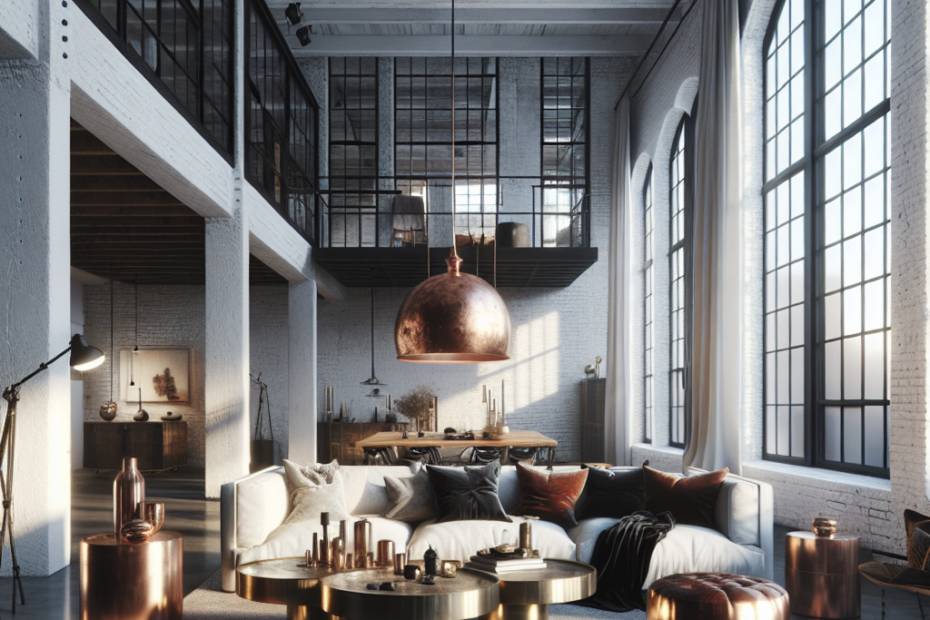“`html
The Essentials of Luxe Industrial Design for Urban Homes
As urban areas continue to grow, homeowners are seeking unique ways to enhance the aesthetic of their living spaces. Enter Luxe Industrial Design, a trend that blends the raw, edgy vibes of industrial spaces with luxurious details for modern homes. This design approach has become increasingly popular in urban settings, transforming cold and barren environments into warm, inviting, and sophisticated living spaces. But what makes Luxe Industrial Design so appealing, and how can it be executed effectively?
Origins and Key Elements
Luxe Industrial Design finds its roots in the conversion of old warehouses and factories into residential areas. These spaces retained elements like exposed brick, weathered wood, and visible ductwork, which have become signatures of industrial design. By adding luxe elements such as plush furniture, elegant lighting, and high-end finishes, homeowners can achieve a balance that feels both raw and refined.
Key elements of Luxe Industrial Design include:
- Exposed Architecture: Open floor plans, visible beams, and exposed pipes create that classic industrial look.
- Textured Walls: Concrete, brick, and reclaimed wood add texture and depth.
- Metal Accents: Use of steel, iron, and brass for a rugged yet chic look.
- Decorative Lighting: Industrial pendant lights or chandeliers make a striking statement.
Blending Comfort with Industrial Chic
For luxe industrial spaces to feel inviting rather than austere, comfort must be a focus. Textiles play a massive role in achieving this balance. Fabrics like velvet, leather, and soft cotton, in neutral or muted colors, add warmth and softness. Plush area rugs can break up hard flooring and inject coziness.
A functional yet stylish approach to furniture is also essential. While industrial design favors minimalist and functional pieces, incorporating luxurious materials can elevate these items. Think of a deep, soft leather sofa paired with a rustic wood coffee table. Stunning artwork and unique sculptures can add a sophisticated touch too.
Color Schemes and Materials
The color palette in a Luxe Industrial Design tends to revolve around neutral tones – think grays, browns, and blacks with splashes of metallic hues. These colors complement the raw materials typically seen in industrial spaces. Incorporating greenery is also important, as it adds life and brightness to the urban industrial environment.
| Element | Description |
|---|---|
| Furniture | Leather, wood, and metal pieces that provide both style and comfort. |
| Lighting | Statement pieces such as pendant lights and chandeliers in metallic finishes. |
| Textures | Mix of materials like brick, concrete, and reclaimed wood for depth. |
| Colors | Neutral tones with metallic accents for a luxurious feel. |
Examples and Inspiration
Many urban homes have successfully incorporated Luxe Industrial Design features to create stunning interiors. For example, a study by the Interior Design Society noted a 25% increase in demand for industrial design elements fused with luxury interiors in metropolitan areas (Interior Design Society, 2023).
Designers often draw inspiration from iconic industrial buildings and add in luxe elements like velvet cushions or gold-toned hardware. Online galleries, design magazines, and social media platforms are brimming with examples of how homeowners have creatively combined these elements to create spaces that are both elegant and practical.
Key Takeaways
- Luxe Industrial Design blends the rawness of industrial elements with luxury details.
- Key design elements include exposed architecture, textured walls, and metal accents.
- Comfort is achieved through plush textiles and thoughtfully chosen furniture.
- Neutral color schemes are complemented by metallics and lush greenery.
- Demand for these design elements is on the rise, especially in urban settings.
FAQ
- What is Luxe Industrial Design?
Luxe Industrial Design combines the rugged elements of industrial spaces with luxurious furnishings and finishes to create elegant urban homes.
- What elements are key to achieving this design style?
The key elements include exposed architecture, textured materials, metal accents, and decorative lighting.
- Can Luxe Industrial Design be comfortable?
Yes, comfort is a crucial component. Incorporating soft textiles, plush rugs, and comfortable furniture achieves coziness.
- What colors work well in Luxe Industrial Design?
Neutral tones like grays, blacks, and browns, with metallic accents, are typical for this design style.
- Are there any resources for inspiration?
Yes, online galleries, design magazines, and social media platforms offer numerous examples and inspiration for Luxe Industrial Design.
“`
This blog post provides a comprehensive overview of Luxe Industrial Design, using third-person narration and incorporating various SEO techniques for optimal web visibility.
